Piezoelectric Ceramics Market by Type (Barium Titanate, Potassium Niobate, Sodium Tungstate, Lead Zirconate Titanate), End user (Consumer Electronics, Industry & Manufacturing, Automotive, Medical), and Region – Global Forecast to 2028
The global piezoelectric ceramics market size is projected to reach USD 1.8 billion by 2028 from USD 1.4 billion in 2023, at a CAGR of 4.9% during the forecast period. The growing demand for piezoelectric ceramics is due to growing need for high-performance sensors. Moreover, rising demand of piezoelectric energy harvesting technology and rising demand from medical sectors in emerging economies such as India, China, Brazil, and others.
Global Piezoelectric Ceramics Market Trend
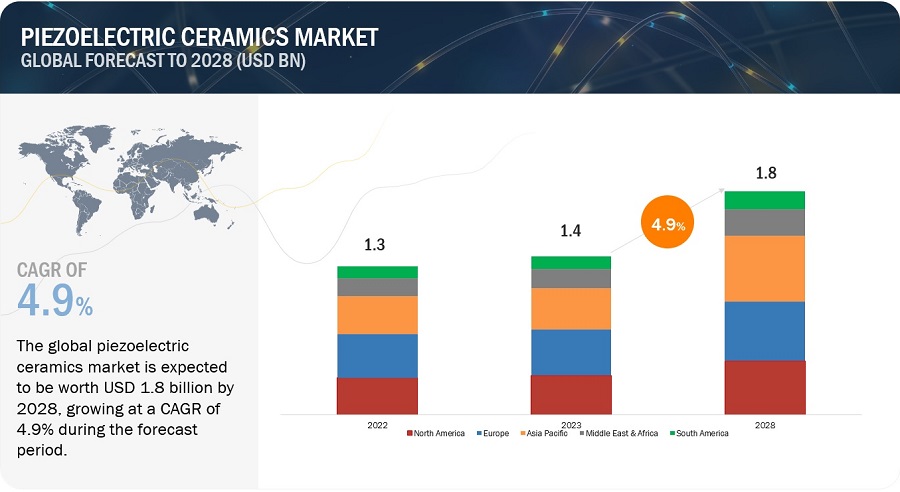
To know about the assumptions considered for the study, Request for Free Sample Report
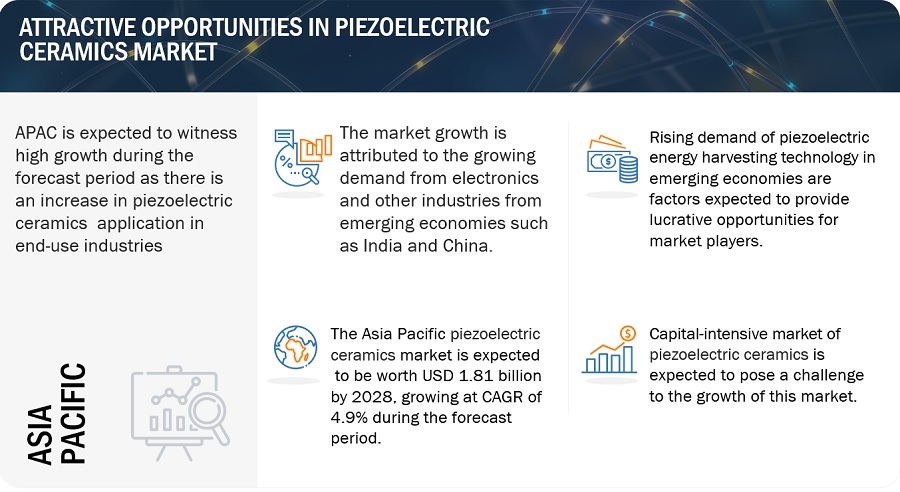
Piezoelectric Ceramics Market Dynamics
Driver: Growing need for high-performance sensors
The growing need for high-performance sensors is a major driver for the increased demand for piezoelectric ceramics. High-performance sensors are crucial in various industries and applications where accurate and reliable measurements are essential. Piezoelectric ceramics exhibit excellent sensitivity, allowing them to convert mechanical signals such as pressure, force, or vibration into electrical signals with high precision. This accuracy is vital in applications where precise measurements are required, such as industrial process control, automotive testing, medical diagnostics, and environmental monitoring.
Restraint: High cost of piezoelectric ceramics material
The high cost of piezoelectric ceramics poses a significant restraint to their widespread adoption in various industries. The production of high-quality piezoelectric ceramics involves complex manufacturing processes. These processes typically include the preparation of raw materials, mixing, shaping, sintering, and poling. Each step requires specialized equipment and expertise, which adds to the overall production cost. The raw materials used in piezoelectric ceramics, such as lead zirconate titanate (PZT), are often costly. These materials are engineered with specific compositions to exhibit the desired piezoelectric properties. The procurement and refinement of these materials can contribute significantly to the overall cost of the ceramics.
Opportunity:Emergence of Internet of Things (IoT) technology
The IoT revolution is driving the demand for sensors and actuators that enable connectivity and intelligence in various applications. Piezoelectric ceramics can provide accurate and responsive sensing capabilities for IoT devices, such as environmental monitoring, structural health monitoring, and smart home systems. The IoT is a network of interconnected devices and systems that collect, exchange, and analyze data to enable intelligent decision-making and automation. Piezoelectric ceramics play a vital role in this ecosystem due to their unique sensing capabilities and energy-harvesting potential. The IoT relies on a wide array of sensors to gather data from the physical world. Piezoelectric ceramics can convert mechanical strain, pressure, or vibrations into electrical signals, enabling accurate and responsive sensing. In the IoT ecosystem, piezoelectric sensors find applications in environmental.
Challenges: Limited raw material options
The limited material options available for piezoelectric ceramics pose a significant challenge to their widespread adoption and growth in the market. Traditionally, piezoelectric ceramics have been primarily based on lead-containing materials, such as lead zirconate titanate (PZT). However, the environmental concerns associated with lead content have led to increasing restrictions and regulations on its usage. The commercial availability and cost-effectiveness of suitable piezoelectric ceramic materials can be a limiting factor. Some high-performance materials may be difficult to procure in large quantities or may come with a high price tag, making them less accessible for widespread industrial applications. Overcoming the limited material options for piezoelectric ceramics researchers are constantly exploring new material compositions, searching for substitutes, and investigating methods to enhance the performance of existing materials.
Market Ecosystem
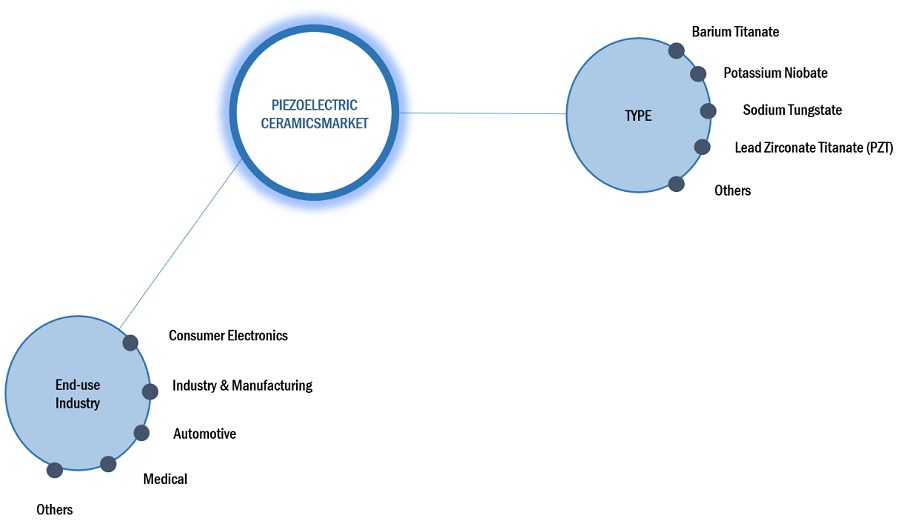
By type, potassium niobate is the fourth largest in piezoelectric ceramics market, in 2022.
Potassium niobate (KNbO3) is a type of piezoelectric ceramic that holds significant importance in the piezoelectric ceramics market. Potassium niobate exhibits a high piezoelectric coefficient, which means it can generate a strong electric charge in response to mechanical stress. It also has a wide operating frequency range, spanning from a few hertz to gigahertz. This property makes it ideal for various applications including medical imaging, non-destructive testing, underwater communication, and frequency control devices.
By end-use industry, automotive segment is the third largest in piezoelectric ceramics market, in 2022.
The automotive industry is one of the largest and most significant sectors for the application of piezoelectric ceramics. ADAS technologies, including collision detection, lane departure warning, and adaptive cruise control, rely on accurate sensing and actuation capabilities. Piezoelectric ceramics are employed in these systems for their ability to convert mechanical signals into electrical signals, enabling precise detection and response to environmental changes.
Asia Pacific is projected to be fastest growing amongst other regions in the piezoelectric ceramics market market, in terms of value.
Based on the region, the piezoelectric ceramics market is segmented into Asia Pacific, North America, Europe, South America, and the Middle East & Africa. Currently, Asia Pacific is the fastest growing market for piezoelectric ceramics. Asia Pacific is known as a global manufacturing hub, with countries like China, Japan, South Korea, and Taiwan leading in the production of various electronic components. This region's strong manufacturing capabilities and expertise make it an ideal location for the production of piezoelectric ceramics. The presence of a well-established supply chain, skilled labor, and advanced manufacturing infrastructure contributes to the growth of the piezoelectric ceramics market in the region.
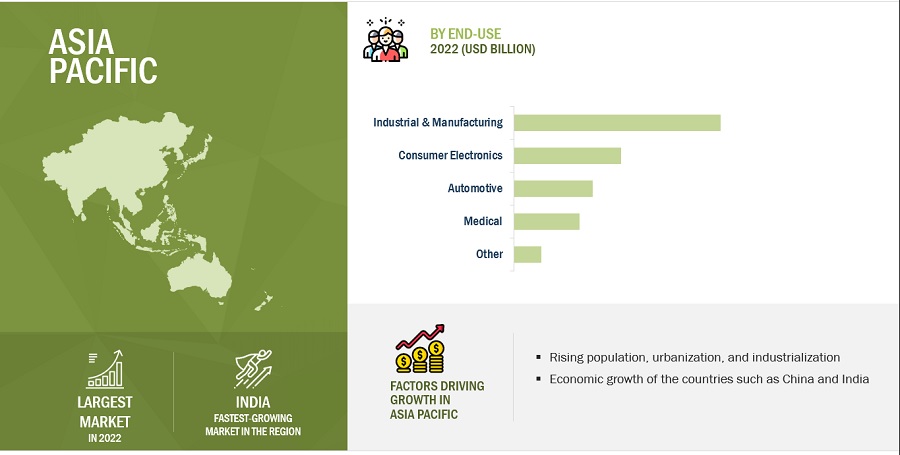
To know about the assumptions considered for the study, download the pdf brochure
Key Market Players
Some of the key players operating in the piezoelectric ceramics market include KYOCERA Corporation (Japan), CeramTec GmbH (Germany), CTS Corporation (US), Murata Manufacturing Co., Ltd (Japan), TDK Corporation (Japan), Physik Instrumente (PI) GmbH & Co. (Germany), APC International, Ltd (US), L3Harris Technologies, Inc (US), HOERBIGER Motion Control GmbH (Germany), and Piezo Technologies (US).
These companies have adopted various organic as well as inorganic growth strategies between 2018 and 2022 to strengthen their positions in the market. The new product launch is the key growth strategy adopted by these leading players to enhance regional presence and develop product portfolios to meet the growing demand for piezoelectric ceramics from emerging economies.
Get online access to the report on the World's First Market Intelligence Cloud
- Easy to Download Historical Data & Forecast Numbers
- Company Analysis Dashboard for high growth potential opportunities
- Research Analyst Access for customization & queries
- Competitor Analysis with Interactive dashboard
- Latest News, Updates & Trend analysis
Request Sample Scope of the Report
Get online access to the report on the World's First Market Intelligence Cloud
- Easy to Download Historical Data & Forecast Numbers
- Company Analysis Dashboard for high growth potential opportunities
- Research Analyst Access for customization & queries
- Competitor Analysis with Interactive dashboard
- Latest News, Updates & Trend analysis
|
Report Metric |
Details |
|
Years considered for the study |
2019-2028 |
|
Base Year |
2022 |
|
Forecast period |
2023–2028 |
|
Units considered |
Value (USD Million/Billion) |
|
Segments |
Type, End-Use Industry, and Region |
|
Regions |
Asia Pacific, North America, Europe, Middle East & Africa, and South America |
|
Companies |
KYOCERA Corporation (Japan), CeramTec GmbH (Germany), CTS Corporation (US), Murata Manufacturing Co., Ltd (Japan), TDK Corporation (Japan), Physik Instrumente (PI) GmbH & Co. (Germany), APC International, Ltd (US), L3Harris Technologies, Inc (US), HOERBIGER Motion Control GmbH (Germany), and Piezo Technologies (US) are the key players in the market. |
This report categorizes the global piezoelectric ceramics market based on type, end-use industry, and region.
On the basis of type, the piezoelectric ceramics market has been segmented as follows:
- Barium Titanate
- Potassium Niobate
- Sodium Tungstate
- Lead Zirconate Titanate (PZT)
- Others
On the basis of end use industry, the piezoelectric ceramics market has been segmented as follows:
- Consumer Electronics
- Industry & Manufacturing
- Automotive
- Medical
- Others
On the basis of region, the piezoelectric ceramics market has been segmented as follows:
- North America
- Asia Pacific
- Europe
- South America
- The Middle East & Africa
The piezoelectric ceramics market has been further analyzed based on key countries in each of these regions.
Recent Developments
- In 2021, KYOCERA Corporation announced an investment of USD 97 million to build two additional production facilities at its Kokubu plant campus in Kagoshima, Japan. The area of one factory will be 5,174 m2 and another will be 6,996 m2. This has helped the company to strengthened its geographical presence in Asia Pacific region.
- In 2021, KYOCERA Corporation started construction of a new research and development center in January 2021 at its Kokubu campus in Kirishima City, Kagoshima, Japan. Kyocera has executed a location agreement with the mayor of Kirishima City for the new R&D center, which will focus on innovations in the fields of information and communications, environmental preservation, and smart energy..
- In 2020, CeramTec GmbH (Germany) expanded its existing production capabilities to meet the rising demand for high-quality piezoelectric elements and materials. The internationally operating company with sites in Europe, the UK, the US, and Asia has invested in two additional machinery units at its Piezoceramic Centre of Excellence in Lauf, Germany, which further multiply existing high-volume manufacturing capabilities for piezoceramic components, such as discs, rings, and tubes, as well as increase automation..
- In 2023, CTS Corporation has acquired maglab AG a Switzerland-based innovator in electric vehicle sensors. This acquisition has helped the company to strengthen its product portfolio in the automotive application in the Europe region.
- In 2022, CTS Corporation has acquired Ferroperm Piezoceramics from Meggitt PLC Denmark based high-quality and innovative piezoceramic technology. This has helped the company to strengthen its geographical presence in Europe and North America.
Frequently Asked Questions (FAQ):
What is the current size of the global piezoelectric ceramics market?
Global piezoelectric ceramics market size is estimated to reach USD 1.8 billion by 2028 from USD 1.4 billion in 2023, at a CAGR of 4.9% during the forecast period.
Who are the winners in the global piezoelectric ceramics market?
Companies such as include KYOCERA Corporation (Japan), CeramTec GmbH (Germany), CTS Corporation (US), Murata Manufacturing Co., Ltd (Japan), TDK Corporation (Japan), Physik Instrumente (PI) GmbH & Co. (Germany), APC International, Ltd (US), L3Harris Technologies, Inc (US), HOERBIGER Motion Control GmbH (Germany), and Piezo Technologies (US).. They have the potential to broaden their product portfolio and compete with other key market players.
What are some of the drivers in the market?
Growing need for high-performance sensors, rising demand from medical sector, and rising demand of piezoelectric energy harvesting technology.
What are the major end-use industries of piezoelectric ceramics?
Consumer electronics, Industrial & manufacturing, Automotive, Medical and Others are some of the major end use industry.
What are the various types of piezoelectric ceramics?
Lead Zirconate Titanate (PZT), Barium Titanate, Sodium Tungstate are some major type of piezoelectric ceramics. .
To speak to our analyst for a discussion on the above findings, click Speak to Analyst
The study involved four major activities in estimating the current market size for piezoelectric ceramics. Exhaustive secondary research was conducted to collect information on the market, peer market, and parent market. The next step was to validate these findings, assumptions, and sizing with industry experts across the value chain through primary research. Both top-down and bottom-up approaches were employed to estimate the complete market size. After that, the market breakdown and data triangulation methodologies were used to estimate the market size of segments and subsegments.
Secondary Research
In the secondary research process, various secondary sources such as Factiva, Zauba, Hoovers, and Bloomberg BusinessWeek were referred to for identifying and collecting information for this study. These secondary sources included annual reports, press releases & investor presentations of companies, white papers, certified publications, articles by recognized authors, The US Advanced Ceramics Association (USACA), regulatory bodies, and databases.
Secondary research has been used to obtain key information about the value chain of the industry, monetary chain of the market, the total pool of key players, market classification and segmentation according to industry trends to the bottom-most level, and regional markets. It was also used to obtain information about the key developments from a market-oriented perspective.
Primary Research
The piezoelectric ceramics market comprises several stakeholders, such as raw material suppliers, distributors of piezoelectric ceramics, end-product manufacturers, and regulatory organizations in the supply chain. The demand side of this market consists of various industries such as consumer electronics, industry & manufacturing, automotive, medical, and others. Various primary sources from both the supply and demand sides of the market were interviewed to obtain qualitative and quantitative information.
Primary interviews were conducted to gather insights such as market statistics, data of revenue collected from the products and services, market breakdowns, market size estimations, market forecasting, and data triangulation. Primary research also helped in understanding the various trends related to technology, raw material, type, end-use industries, and region. Stakeholders from the demand side, such as CIOs, CTOs, and CSOs were interviewed to understand the buyer’s perspective on the suppliers, products, component providers, and their current usage of piezoelectric ceramics and future outlook of their business which will affect the overall market.
Following is the breakdown of primary respondents.
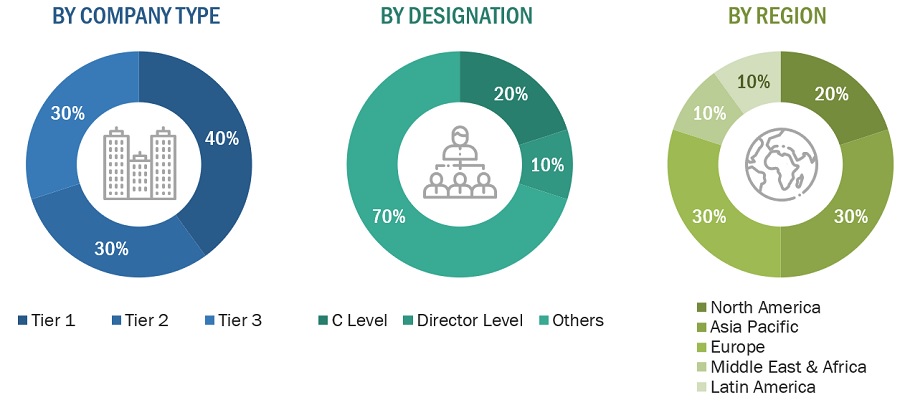
To know about the assumptions considered for the study, download the pdf brochure
Market Size Estimation
Both top-down and bottom-up approaches were used to estimate and validate the total size of the piezoelectric ceramics market. These methods were also used extensively to determine the size of various subsegments in the market. The research methodology used to estimate the market size includes the following:
- The key players in the industry and markets were identified through extensive secondary research.
- The industry’s supply chain and market size, in terms of value and volume, were determined through primary and secondary research processes.
- All percentage shares, splits, and breakdowns were determined using secondary sources and verified through primary sources.
Piezoelectric Ceramics Market: Bottom-Up Approach

Note: All the shares are based on the global market size.
Source: Secondary Research, Interviews with Experts, and MarketsandMarkets Analysis
To know about the assumptions considered for the study, Request for Free Sample Report
Piezoelectric Ceramics Market: Top-Down Approach

Data Triangulation
After arriving at the overall market size—using the market size estimation process explained above—the market was split into several segments and sub-segments. To complete the overall market engineering process and arrive at the exact statistics of each market segment and subsegment, the data triangulation, and market breakdown procedures were employed, wherever applicable. The data was triangulated by studying various factors and trends from both the demand and supply of piezoelectric ceramics and their applications.
Market Definition
Piezoelectric ceramics are a type of ceramic material that possesses the property of piezoelectricity. Piezoelectricity refers to the ability of certain materials to generate an electric charge in response to applied mechanical stress or strain, and vice versa, to undergo mechanical deformation or vibration when an electric field is applied. Piezoelectric ceramics are typically made from various compositions of metal oxides, such as lead zirconate titanate (PZT), barium titanate (BaTiO3), or potassium niobate (KNbO3). These ceramics have a crystalline structure that is asymmetrical, with positive and negative charges arranged in a non-centrosymmetric manner. This structural arrangement allows them to exhibit the piezoelectric effect. When an external force or pressure is applied to a piezoelectric ceramic, the crystal lattice of the material deforms, causing a displacement of positive and negative charges. This displacement results in the generation of an electric field and an electric charge across the material. Similarly, when an electric field is applied to the ceramic, it causes a mechanical deformation or vibration due to the movement of charges within the crystal lattice.
Key Stakeholders
- Senior Management
- End User
- Finance/Procurement Department
- R&D Department
Objectives of the Study:
- To define, describe, and forecast the piezoelectric ceramics market, in terms of value.
- To provide detailed information about the key factors (drivers, restraints, opportunities, and challenges) influencing the market growth
- To analyze and forecast the market by type and end-use industry.
- To forecast the size of the market for five regions, namely, Asia Pacific, Europe, North America, South America, and the Middle East & Africa along with their key countries
- To strategically analyze micromarkets with respect to individual growth trends, prospects, and contribution to the total market
- To analyze the opportunities in the market for stakeholders and provide a competitive landscape for market leaders.
- To analyze competitive developments, such as new product launch, acquisition, and expansion undertaken in the market
- To strategically profile key players and comprehensively analyze their market ranking and core competencies.
Available Customizations
With the given market data, MarketsandMarkets offers customizations according to the specific requirements of companies. The following customization options are available for the report:
Regional Analysis:
- Country-level analysis of the piezoelectric ceramics market
Company Information:
- Detailed analysis and profiling of additional market players












Growth opportunities and latent adjacency in Piezoelectric Ceramics Market